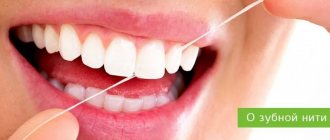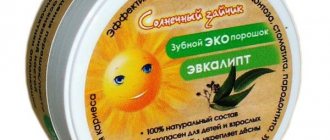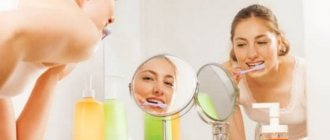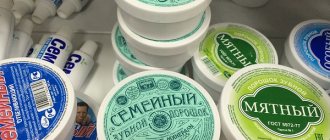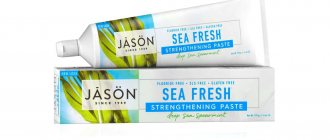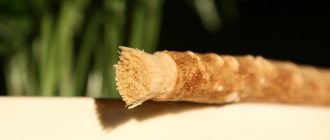Purpose
It should be noted that at that time the purpose of tooth powder was not to prevent caries or treat periodontitis. At that time they did not even know such words, did not understand the reasons for their occurrence, and therefore could not yet contain these diseases with hygienic means. The main and only goal was to cleanse the teeth of plaque and tartar. Please note: in the first half of the 20th century, dentists had not yet performed such a now widespread procedure as professional oral hygiene. Neither ultrasonic nor air-abrasive (Air-Flow) treatment had yet been invented. The only way to remove conspicuous plaque is to clean it yourself.
Which is safer?
Tooth powder still confuses some due to the presence of small particles that can be accidentally inhaled while brushing your teeth. Indeed, there is such a possibility. But only small children should be afraid of it. Curiosity may cause them to bring the container of powder closer to their nose, and then the risk of inhaling small particles will increase. Greenway powder is not prohibited for use by children, but the manufacturer recommends doing so only under adult supervision.
READ ALSO: Advantages of white kitchens
Tooth powder is often accused of being unhygienic. They say that you need to dip a wet brush into it, which leads to the moistening of the granules and the proliferation of bacteria in the container with them. That's how it is. But it all depends on the composition of the product. If it contains components that kill harmful microorganisms, the risk is reduced to zero. In Greenway powder, sea salt plays the role of protection against bacteria.
Starting line-up
Therefore, a good century-old tooth powder is one that has excellent abrasive properties. Hence they added to it: pumice, sand, ground bones, eggshells, mollusk shells, broken bricks and God knows what else. It must be said that toothpastes of those times were in no way behind powders in terms of abrasiveness. Moreover, to help a good cause, individual inventors added acids and alkalis of varying degrees of aggressiveness to them. Well, of course - after all, tartar softened by acid is easier to remove (alkali has not proven its worth in this regard). In general, the evolution of hygiene products has moved towards clearly expressed aggressiveness.
How to cook at home
In addition to factory-made powders, many craftsmen use self-made products. Their advantages are the naturalness and availability of the main ingredients.
To prepare the product you will need:
- White clay;
- sage leaves;
- thyme;
- Oak bark.
We have listed the names of vitamins for teeth and gums for adults, which are most often prescribed by dentists. In the next article we will tell you how effective Crest Whitestrips are.
At this address: https://dentist-pro.ru/krasota-i-uxod/preparaty-i-produkty/kak-ukrepit-v-domashnix-usloviyax.html - you can find information on how to strengthen your gums at home.
All components are thoroughly crushed using a blender, coffee grinder or a regular mortar. The main thing is that the composition is homogeneous and does not contain large particles . You can add a few drops of mint or eucalyptus oil to the finished mixture. The resulting product must be stored in a hermetically sealed container in a place protected from direct sunlight.
Some recipes for making powder recommend adding soda as a base. However, you should be careful with this substance: it has an aggressive effect on tooth enamel, so you should replace it with clay or carefully crushed salt.
This video describes a recipe for making herbal tooth powder:
Harm
But in 1907, an outstanding article was published in The Dental Cosmos: Miller WD. Experiments and observations of the wasting of tooth tissue variously designated as erosion, abrasion, chemical abrasion, denudation, etc. It had about the same impact on dentists as Albert Einstein’s “On the Electrodynamics of Moving Bodies,” published two years earlier, had on physicists. Equipped with terrifying illustrations, it clearly demonstrated the monstrous abrasion of teeth (in vitro) with pastes and powders. Here's one example:
Quality improvement
Of course, not all dentists read this study. Consumers of the powder certainly had no idea about it. Therefore, it took decades before highly abrasive components began to be abandoned. Such useful indicators as RDA (relative dentin abrasivity) and REA (relative enamel abrasivity) were introduced. The lower they are, the less the teeth wear out. Today, manufacturers who respect their customers indicate digital RDA values on each tube. Less than 70 – low abrasiveness, 71-100 – moderate, 101-150 – high, 151-200 – very high. Here is the RDA table for some modern pastes:
| Toothpaste name | RDA | Toothpaste name | RDA |
| Toothbrush with plain water | 4 | Colgate Sensitive Max Strength | 83 |
| Regular baking soda | 7 | Aquafresh Sensitive | 91 |
| Weleda Salt Toothpaste | 15 | Sensodyne Cool Gel | 92 |
| Elmex Sensitive Plus | 30 | Rembrandt Plus | 94 |
| Sensodyne ProNamel | 34 | Sensodyne Fresh Impact | 94 |
| Arm & Hammer Dental Care | 35 | Sensodyne Original | 100 |
| Weleda Calendula Toothpaste | 45 | Sensodyne Extra Whitening | 104 |
| Weleda Ratanhia Toothpaste | 45 | Sensodyne Full Protection Whitening | 107 |
| Arm & Hammer Dental Care Sensitive | 48 | Aquafresh Whitening | 113 |
| Tom's of Maine Children Toothpaste | 57 | Lacalut White | 120 |
| Colgate Sensitive Enamel Protect | 63 | Colgate Total Whitening | 142 |
| ClinPro | 65 | Colgate Total Advanced Fresh | 160 |
| Colgate Regular | 68 | Colgate Tartar Control | 165 |
| Colgate Total | 70 | Colgate 2-in-1 Tartar Control/Whitening | 200 |
| Colgate Fresh Mint | 70 | President White Plus | 200 |
Modern composition
So, coarse abrasives were disqualified from the contents of tooth powder. But what is there now? Soda, as can be seen from the table, has minimal harmful qualities. It is harmless, but its effectiveness is low. It weakly cleans plaque and does not “take away” tartar at all. Its hardness on the Mohs scale is 2.5. That's why the main ingredient in today's tooth powders is chalk (calcium carbonate). Its hardness on the Mohs scale is 3. It cleans teeth relatively gently and is more effective than soda. The rest is fragrances, flavor enhancers, dyes, etc.
Popular brands
Blend-a-med PRO-EXPERT effectively removes plaque, freshens breath, protects against caries and tartar, and reduces tooth sensitivity. Contains polyphosphates and stabilized tin, which have a beneficial effect on the condition of teeth and gums: strengthens and gently whitens the enamel.
To read: Is it possible to remove a tooth during menstruation?
The German paste Lacalut is recommended for adults and children, which prevents the deposition of tartar, strengthens gums, and freshens breath.
International offers Colgate paste with a different set of medicinal herbs, anti-inflammatory, whitening, enamel strengthening effect,
“Forest balm”, as well as rinses based on medicinal herbs, with aloe vera, for various purposes, depending on the composition of medicinal plant components, are recommended for oral care and the prevention of dental problems.
Popular among consumers:
- Aquafresh,
- Paradontax,
- New pearls
- Splat Professional Active (does not contain fluorine).
The final victory of toothpaste
Back in 1914, there were attempts to introduce fluoride into toothpaste. But only after large-scale research in the early 1950s, which proved the effectiveness of fluoride toothpastes, did active commercial production begin. The pioneer was Procter & Gamble with Crest toothpaste. Then the rest of the manufacturers picked up the baton. In addition to fluorides (to prevent caries), antiseptics and anti-inflammatory components (to fight gingivitis), and desensitizing substances (to reduce dental hyperesthesia) began to be added to the paste.
How to choose?
When choosing a toothpaste, pay attention to the addition to its name:
- Active – means that the product is recommended for periodontal disease,
- White – produces a whitening effect due to high abrasiveness and peroxide content (citric acid),
- Sensitive – designed to reduce excessive tooth sensitivity,
- Fito – contains medicinal herbs.
Then check: the integrity of the packaging (tube), the release date (expiration date - 3 years). Familiarize yourself with the composition of the components: fluoride concentration should not exceed 2%, abrasiveness should not exceed 100 according to the RDA standard.
Where in the world is it used?
In developed countries, tooth powder is not produced. The last known global leader in the hygiene industry, Arm & Hammer, ceased sales in 2000. In Russia, tooth powder is used by 23% of the population. A recent study was conducted in India in 2022: it was found that 31% of rural residents and 15% of urban respondents use tooth powder. A strong relationship has been found between the use of tooth powder and abrasion of tooth tissue, bleeding and gum recession. This is the “beauty” you get after consuming Indian tooth powder:
Toothpaste or tooth powder?
To make up our minds, we are usually guided by the opinions of others or, trying to find an independent source of information, we pose the question to the Internet or the dentist: what is better - toothpaste or powder?
Since chalk and other ingredients that destroy teeth were previously regularly used in the production of tooth powder, the level of confidence in them has dropped.
In the past, tooth powders contained small amounts of active substances, which led to their low price. In addition, the tooth powder contained a small amount of minerals. But now, when pharmacology, like dentistry, has reached a different level, attention to them is gradually returning.
For example, manufacturers of tooth powders made from natural ingredients base the entire production of this product on the use of white clay, known for its healing effects. The powder, which contains white clay, actively fights the formation of tartar and bacterial plaque; just remember the advertisement for Orbit chewing gum, which was based on this component.
In addition to white clay, tooth powder can also consist of pink clay, as well as volcanic tuff and various minerals. The main functions of tooth powder are considered to provide therapeutic and preventive effects for periodontal disease, reducing swelling in the gums, normalizing the acid-base balance in the mouth, protecting against caries, strengthening tooth enamel, as well as loosening tartar and whitening.
Toothpaste adherents will now begin to protest, what choice can there be - toothpaste or toothpowder, if toothpaste has the same properties, but is more familiar and pleasant?
Toothpaste fights the same problems, but does not loosen tartar due to its structure. But, again, if you decide to buy tooth powder that is not made from natural ingredients, it can destroy tooth enamel, not provide the necessary preventive effect and not provide “internal nutrition” to the tooth. Therefore, we must proceed with caution here.
[:product:biob0023:]
[:product:biob0024:]
[:product:biob0025:]
To once and for all dispel all disputes about what is better, toothpaste or tooth powder, we will tell you one secret.
Despite all the controversy and misconceptions, leading dentists say that you should use tooth powder, but only 1-2 times a week. There are a number of things to consider before running to the bathroom to get your toothbrush.
- For optimal teeth whitening and cleaning, it is best to use an electric toothbrush when using tooth powder.
- You should brush your teeth twice during one brushing session, and then rinse your mouth thoroughly with water and brush your teeth with toothpaste.
Thus, as Agnia Barto said in a children's poem, “all professions are needed, all professions are important.” In this case, this quote, of course, should be taken as metaphorical, but it is precisely with it that all of the above can be summarized.
[:product:veda0001:]
[:product:veda0002:]
Look after your teeth, take care of them, and that’s when you will become the proud owner of a snow-white smile.
How to brush your teeth correctly
Please note that despite the fact that most of the Indian tooth powder fan's own enamel has been erased, the black plaque has not been cleaned out everywhere. And this is on the front surface - you can imagine how much worse the situation is on the internal surfaces. This happens because brushing your teeth requires, first of all, not strength, but intelligence. Instead of violent movements, moderate but frequent movements are needed. Not horizontal, but vertical, sweeping. From the gum to the tooth: from bottom to top - on the lower jaw, from top to bottom - on the upper jaw. And, naturally, you need to brush your teeth not only on major holidays, but every day. Then the soft plaque will not yet have time to calcify and stick firmly to the enamel.
Flaws
Despite these advantages, when deciding to use tooth powder, it is worth familiarizing yourself with its disadvantages. The most important of them include the following:
- The high abrasiveness of the substance has a strong scratching effect on the enamel. With frequent use of the product, thinning of the enamel develops and the likelihood of developing non-carious lesions increases. It is not advisable to use the powder for people with highly sensitive tooth enamel.
- The presence of wounds and ulcers on the gum line excludes the possibility of using the powder, since its particles can worsen the situation.
- Inability to eliminate specific dental problems due to the limited number of medicinal supplements.
- The absence of a dispenser in the package complicates the use of the drug and leads to its moistening and the development of bacteria on it.
You will be interested to find out reviews and prices for ultrasonic teeth cleaning procedures in the review prepared for you. In this article, we told you which is the best oral irrigator to choose.
Features of use
For tooth powder, the instructions for use are a little more complicated than for toothpaste. The toothbrush should be moistened with water and the wet bristles should be dipped into a jar of powder. It is advisable to immediately collect a portion for the entire one-time cleaning. After all, when re-sampling, microorganisms will get into the powder. Bacteria, by the way, will still end up in the jar (unless you use disposable brushes), because they remain on the fibers from the previous cleaning. But in the 12 hours that have passed since the last hygiene procedure, most of the microbes have already died and do not pose any danger to the owner. The same cannot be said about other members of the family. Therefore, everyone should have a personal jar of tooth powder - otherwise there is a high risk of infecting close relatives. This is another inconvenience compared to toothpaste - the whole family can use a common tube.
Positive aspects of use
Modern tooth powders are much safer and healthier than those that were so common some time ago. Not many people know that in addition to direct cleaning, this product can also be used for medicinal purposes .
Here is a short list of useful properties and positive aspects of using tooth powder:
- High-quality removal of food debris.
- Loosening of dense deposits - tartar, plaque - for effective removal.
- Cleans the surface of teeth through gentle polishing.
- Lightening the shade of enamel and removing superficial pigment spots.
- Prevention of inflammatory diseases of periodontal tissues.
- Reducing the intensity of gingivitis manifestations.
- Strengthening gums.
- Strengthening enamel due to the presence of calcium compounds and natural clay.
First of all, the powder will be indispensable for those who suffer from bleeding gums and inflammation. The beneficial properties of the powder include its ability to reduce the manifestations of inflammation, as well as eliminate bleeding.
To do this, after cleaning, apply powder slightly diluted with water to a paste on the inflamed areas and leave for a while . Applications of this kind can be carried out periodically, as the need arises.
In addition, regular use of tooth powder helps normalize the acid-base balance in the oral cavity . This occurs due to the properties of the components included in the product.
By neutralizing high acidity, the powder not only has a positive effect on soft tissues, but also prevents the excessive development of bacteria and, accordingly, prevents caries.
Is teeth whitening using baking soda and hydrogen peroxide effective? What precautions should you take?
In a separate article we will explain why pregnancy is a relative contraindication for ultrasonic teeth cleaning.
Here https://www.vash-dentist.ru/krasota-i-uxod/opolaskivateli/obzor-dlya-polosti-rta-lesnoy-balzam.html you will find reviews about the “Forest Balsam” mouth rinse.
Reviews
Why then are there such a huge number of positive reviews about tooth powder on the Internet and among friends? It’s not surprising - there are also a lot of words of praise about homeopathy and osteopathy. Valerian, Actovegin, Linex and a hundred or two other ineffective drugs find no less devoted admirers. A person is such an amazing creature that, having convinced himself of the usefulness of a particular drug, he can actually achieve a positive effect, even if this drug is an absolute dummy. This is called the placebo effect. After persistent self-hypnosis, the transition to truly more effective therapeutic and prophylactic agents is often met with hostility. Plus, irreversible negative consequences do not occur immediately. They include, among other things, the absence of a positive impact (prevention of diseases), which few fans think about.
What is
In most cases, the base of any teeth cleaning powder is chalk. However, not natural, which was previously used in a crushed state. Modern manufacturers use artificially produced chemically precipitated chalk.
It is this substance that has some features that allow it to be used to clean enamel without causing harm to it . This is a finely dispersed compound, the crystals of which have a very small size and different shapes - prismatic, spherical and diamond-shaped.
The basis of this component is calcium carbonate, in addition to which it also contains aluminum and iron oxides, magnesium carbonate and silicon dioxide.
Chemically precipitated chalk in tooth powder occupies almost the entire volume - about 98–99%. The remaining 1 or 2% are fragrances and various active additives to give the product certain properties - preventive or therapeutic.
These may include sea salt, dry clay, crushed dry medicinal herbs, soda, essential oils, useful minerals, etc.
For the effective use of tooth powder, watch the video:
Natural product
In addition to the low cost and supposedly better cleansing effect, many people are attracted to tooth powder by its environmental friendliness. Sodium lauryl sulfate, methylparaben, cocamidopropyl betaine and other horrors in toothpastes cause pronounced protest and rejection among many citizens. It’s difficult to argue with anything here - if you are a staunch opponent of “chemistry”, perhaps tooth powder is your choice. Only then be consistent - if your teeth suddenly hurt, do not treat them. After all, all modern fillings, crowns, dentures, and implants are also made of artificial materials. The natural behavior would be to remove the tooth, as our ancestors did (including those who used tooth powder a hundred years ago).
Powder with whitening effect
Tooth powder that whitens teeth is also not uncommon, and can be easily found in pharmacy displays. It not only cleans the surface of the teeth well, but also restores the natural color of the enamel.
Powders specially designed for teeth whitening can be used not only for cleaning, but also as applications. You just need to dilute the powder to a thick paste and apply it to your teeth. You don’t need to hold it for too long; 15 minutes is enough.
The composition of such powders includes soda and special microgranules containing additional chemical elements. This tooth powder has, of course, positive reviews, but dentists do not recommend using it too often. Twice a week will be enough. On other days, experts advise using either regular powder or toothpastes. If you are concerned about your enamel, then you should choose herbal powders.
Reviews from doctors
Why then do dentists recommend tooth powder? Well, not all dentists, but only some. And these latter are a minority. Of this minority, one half has never read a single book on their specialty in their lives (yes, don’t doubt it – such copies exist). I read the second half, but these were reprints of Soviet textbooks from the 30s (and toothpaste was not produced in the USSR until 1950). And the third half, although familiar with modern concepts, understood little about them. If you ask such scholars the question: “What randomized controlled studies are you willing to refer to to confirm your recommendation?”, you may encounter the most unexpected response.
How is tooth powder used?
The method of use is somewhat different from the methods of using cleaning toothpastes familiar to the modern generation of people. Remember that rubbing your teeth with dry powder is strictly prohibited, as this can seriously damage the enamel. First, you need to wet your toothbrush and only then dip it into the substance. Then the powder will become soft, turning into a paste that is easy to clean.
There is no need to put powder on the brush directly from the box itself. First, using a regular teaspoon, just a dry one, take out the required amount of product and dip the brush in it.
The cleaning process should last at least three, but no more than five minutes. And it is advisable to make two passes, each time picking up new powder on the brush.
After cleaning is completed, your mouth should be rinsed very thoroughly. Pay special attention to the gaps that exist between the teeth. Tooth powder, reviews of the use of which are mostly positive, can act quite aggressively if the tooth enamel is damaged or is already quite thinned. This is also confirmed by dentists who recommend alternating methods of cleaning teeth, that is, changing powder and toothpaste.
Conspiracy of toothpaste manufacturers
But there are also completely unique opinions from dentists. One well-known Moscow orthodontist (a competent doctor, a supporter of evidence-based medicine) posted a publication on her own website: “How dangerous is tooth powder?” With 31 links to sources of information - to give due weight to your own words. The article contains a lot of reliable information, but the conclusions are paradoxical. From the thesis about the higher abrasiveness of certain toothpastes compared to some tooth powders, the author concludes that the superiority of toothpaste over tooth powder is a myth. Formed by advertising from greedy paste manufacturers. No analysis or explanation of why evil advertisers chose for promotion a powder that was not well-known to everyone at that time, but a new, unpromoted product (and, therefore, requiring greater campaign costs) is naturally not presented. This same characteristic mistake is also popular among patients. But you only have to think a little to realize that it is much easier to advertise a cheap, low-cost, and even much more popular product to increase its selling price - and the conspiracy theory will naturally dissolve.
Features of the composition of toothpastes
With the launch of the production of paste-like products, it was possible to significantly simplify the process of oral hygiene. Narrowly targeted preventive and medicinal substances allow you to carefully care for your teeth, prevent the development of diseases and eliminate them in the initial stages. We list the most common components of the composition:
- Enzymes papain, bromelain, polydone and pyrophosphates contribute to the rapid removal of bacterial plaque. They penetrate surface deposits, making them soft and loose. This makes it possible to effectively clean even tartar.
- Active oxygen particles. The foam mass with the presence of this component penetrates even into remote and hard-to-reach places in the interdental space. Helps remove pigment plaque from microcracks. Thanks to this, it effectively whitens enamel.
- Abrasives. They provide cleaning by mechanical friction of large particles against the surface. Depending on the degree of coarseness of the abrasive elements, the compositions can remove tartar or gently polish teeth. However, you should not abuse highly aggressive compounds. They make the enamel thinner, can injure it and lead to pain.
Among the components used there are substances unsafe for human health:
- sodium lauryl sulfate;
- triclosan;
- fluorine;
- sweeteners;
- antibiotics, etc.
